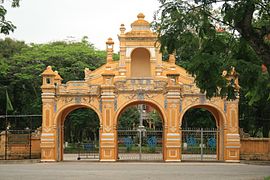Nguyễn dynasty
Đại Việt quốc大越國 (1802–1804) Việt Nam quốc越南國 (1804–1839, 1945)Đại Nam quốc大南國 (1839–1945) | |||||||||||||||||||
|---|---|---|---|---|---|---|---|---|---|---|---|---|---|---|---|---|---|---|---|
| 1802–1945 | |||||||||||||||||||
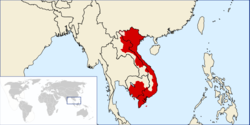 Vietnam at its greatest territorial extent in 1840 (under Emperor Minh Mạng), superimposed on the modern political map | |||||||||||||||||||
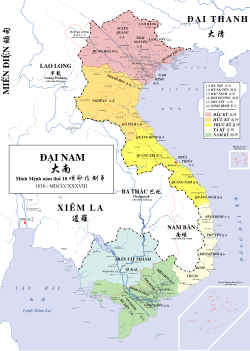 Administrative divisions of Vietnam in 1838 (under Emperor Minh Mạng) | |||||||||||||||||||
| Status | Internal imperial system within Chinese tributary (1802–1884)[1][2]French protectorate (1884–1945)[3][4]Puppet state of the Empire of Japan (1945)[5][6] | ||||||||||||||||||
| Capital | Phú Xuân (now Huế) 16°28′N 107°36′E / 16.467°N 107.600°E | ||||||||||||||||||
| Official languages | VietnameseWritten Classical Chinese[7][8][a]French (from 1884) | ||||||||||||||||||
| Religion | Neo-Confucianism, Buddhism, Catholicism | ||||||||||||||||||
| Government | Absolute monarchy | ||||||||||||||||||
| Emperor | |||||||||||||||||||
• 1802–1820 (first) | Gia Long | ||||||||||||||||||
• 1885 (last independent) | Hàm Nghi | ||||||||||||||||||
• 1926–1945 (last) | Bảo Đại | ||||||||||||||||||
| History | |||||||||||||||||||
| July 1802 | |||||||||||||||||||
• Coronation of Gia Long | 1 June 1802 | ||||||||||||||||||
• French invasion | 1 September 1858 | ||||||||||||||||||
| 5 June 1862 | |||||||||||||||||||
| 25 August 1883 | |||||||||||||||||||
| 6 June 1884 | |||||||||||||||||||
| 9 March 1945 | |||||||||||||||||||
| 25 August 1945 | |||||||||||||||||||
| Area | |||||||||||||||||||
| 1830 | 557,000 km2 (215,000 sq mi) | ||||||||||||||||||
| Population | |||||||||||||||||||
• 1830 | 10,500,000[citation needed] | ||||||||||||||||||
• 1858 | 12,031,000[citation needed] | ||||||||||||||||||
• 1890 | 14,752,000[citation needed] | ||||||||||||||||||
| Currency | Zinc and copper-alloy cash coins (denominated in phần, văn, mạch, and quán) Silver and gold cash coins and ingots (denominated in phân, nghi, tiền, and lạng / lượng) French Indochinese piastre (from 1885) | ||||||||||||||||||
| |||||||||||||||||||
| Today part of | Vietnam Laos Cambodia China | ||||||||||||||||||
The Nguyễn dynasty (Chữ Nôm: 茹阮, Vietnamese: Nhà Nguyễn; Hán tự: 阮朝, Vietnamese: Nguyễn triều) was the last Vietnamese dynasty, which ruled the unified Vietnamese state largely independently from 1802 to 1884. During its existence, the empire expanded into modern-day southern Vietnam, Cambodia, and Laos through a continuation of the centuries-long Nam tiến and Siamese–Vietnamese wars. After 1883, the Nguyễn emperors ruled nominally as heads of state of the French protectorates of Annam and Tonkin until the final months of WWII; they later nominally ruled over the Empire of Vietnam until the Japanese surrender.
The Nguyễn Phúc family established feudal rule over large amounts of territory as the Nguyễn Lords by the 16th century before defeating the Tây Sơn dynasty and establishing their own imperial rule in the 19th century. The dynastic rule began with Gia Long ascending the throne in 1802, after ending the previous Tây Sơn dynasty. The Nguyễn dynasty was gradually absorbed by France over the course of several decades in the latter half of the 19th century, beginning with the Cochinchina Campaign in 1858 which led to the occupation of the southern area of Vietnam. A series of unequal treaties followed; the occupied territory became the French colony of Cochinchina in the 1862 Treaty of Saigon, and the 1863 Treaty of Huế gave France access to Vietnamese ports and increased control of its foreign affairs. Finally, the 1883 and 1884 Treaties of Huế divided the remaining Vietnamese territory into the protectorates of Annam and Tonkin under nominal Nguyễn Phúc rule. In 1887, Cochinchina, Annam, Tonkin, and the French Protectorate of Cambodia were grouped together to form French Indochina.
The Nguyễn dynasty remained the formal emperors of Annam and Tonkin within Indochina until World War II. Japan had occupied Indochina with French collaboration in 1940, but as the war seemed increasingly lost, overthrew the French administration in March 1945 and proclaimed independence for its constituent countries. The Empire of Vietnam under Emperor Bảo Đại was a nominally independent Japanese puppet state during the last months of the war. It ended with Bảo Đại's abdication following the surrender of Japan and August Revolution by the anti-colonial Việt Minh in the August 1945. This ended the 143-year rule of the Nguyễn dynasty. Many Vietnamese historians have a harsh and poor assessment of the Nguyễn dynasty.[9]
Names[]
Việt Nam[]
| Country of Vietnam | |
 | |
| Vietnamese alphabet | Nước Việt Nam |
|---|---|
| Hán-Nôm | 渃越南 |
The name Việt Nam (Vietnamese pronunciation: [viə̀t naːm], chữ Hán: 越南) is a variation of Nam Việt (南越; literally "Southern Việt"), a name that can be traced back to the Triệu dynasty of the 2nd century BC.[10] The term "Việt" (Yue) (Chinese: 越; pinyin: Yuè; Cantonese Yale: Yuht; Wade–Giles: Yüeh4; Vietnamese: Việt) in Early Middle Chinese was first written using the logograph "戉" for an axe (a homophone), in oracle bone and bronze inscriptions of the late Shang dynasty (c. 1200 BC), and later as "越".[11] At that time it referred to a people or chieftain to the northwest of the Shang.[12] In the early 8th century BC, a tribe on the middle Yangtze were called the Yangyue, a term later used for peoples further south.[12] Between the 7th and 4th centuries BC Yue/Việt referred to the State of Yue in the lower Yangtze basin and its people.[11][12] From the 3rd century BC the term was used for the non-Chinese populations of south and southwest China and northern Vietnam, with particular ethnic groups called Minyue, Ouyue, Luoyue (Vietnamese: Lạc Việt), etc., collectively called the Baiyue (Bách Việt, Chinese: 百越; pinyin: Bǎiyuè; Cantonese Yale: Baak Yuet; Vietnamese: Bách Việt; "Hundred Yue/Viet"; ).[11][12][13] The term Baiyue/Bách Việt first appeared in the book Lüshi Chunqiu compiled around 239 BC.[14] By the seventeenth and eighteenth centuries, educated Vietnamese called themselves and their people as nguoi viet and nguoi nam, which combined to become nguoi viet nam (Vietnamese people). However, this designation was for the Vietnamese themselves and not for the whole country.[15]
The form Việt Nam (越南) is first recorded in the 16th-century oracular poem Sấm Trạng Trình. The name has also been found on 12 steles carved in the 16th and 17th centuries, including one at Bao Lam Pagoda in Hải Phòng that dates to 1558.[16] In 1802, Nguyễn Phúc Ánh (who later became Emperor Gia Long) established the Nguyễn dynasty. In the second year of his rule, he asked the Jiaqing Emperor of the Qing dynasty to confer on him the title 'King of Nam Việt / Nanyue' (南越 in Chinese character) after seizing power in Annam. The Emperor refused because the name was related to Zhao Tuo's Nanyue, which included the regions of Guangxi and Guangdong in southern China. The Qing Emperor, therefore, decided to call the area "Việt Nam" instead.[17] Between 1804 and 1813, the name Vietnam was used officially by Emperor Gia Long.[b]
Đại Nam[]
| Empire of Đại Nam | |
| Vietnamese alphabet | Đại Nam Quốc |
|---|---|
| Hán-Nôm | 大南國 |
In 1839, under the rule of Emperor Minh Mạng's, Đại Việt Nam was shortened to Đại Nam (大南, which means "Great South").[19][20]
Other names[]
Westerners in the past often called the kingdom as Annam[21][22] or the Annamite Empire.[23] However, in Vietnamese historiography, modern historians often refer to this period in Vietnamese history as Nguyen Vietnam,[24] alternatively spelled as Nguyễn Vietnam, or simply Vietnam to distinguish with the pre-19th century Đại Việt kingdom.[25]
History[]
Background and establishment[]
Nguyễn lords[]
Origin[]
The Nguyễn family clan, originated in the Thanh Hóa Province, exerted substantial political influence and military power, in particular throughout early modern Vietnamese history. Affiliations with the ruling elite date back to the tenth century when Nguyễn Bặc was appointed the first Grand Chancellor of the short-lived Đinh dynasty under Đinh Bộ Lĩnh in 965.[26] Nguyễn Thị Anh, a queen consort of emperor Lê Thái Tông served as official regent of Đại Việt for her son emperor Lê Nhân Tông between 1442 and 1453.[27]

Lê dynasty's servants[]
In 1527 Mạc Đăng Dung, after defeating and executing the Lê dynasty's vassal (Nguyễn Hoằng Dụ) in a rebellion and emerged as the intermediate victor and established the Mạc dynasty by deposing emperor Lê Cung Hoàng of the once prosperous but rapidly declining later Lê dynasty. Nguyễn Hoằng Dụ's son Nguyễn Kim and his Trịnh clan allies remained loyal to the Lê dynasty and attempted to restore the Lê dynasty to power, thereby reigniting the rebellion.[28][29] After that, both the Trịnh and Nguyễn clan again took up arms in Thanh Hóa province and revolted against the Mạc. However the rebellion was failed and they fled to kingdom of Lan Xang where the king Photisarath allows them to establish the exiled government in Xam Neua. The Lê royalists under Lê Ninh, a descendant of the Royal family, escaped to Muang Phuan (today Laos). During exile, Marquis of An Thanh Nguyễn Kim summoned the people who were still loyal to the Lê emperor and formed a new army to begin a revolt against Mạc Đăng Dung. In 1540, they return to Đại Việt and begin their first military campaign against Mạc dynasty in Thanh Hóa province and capture the province in 1543.
Nguyễn's dominion in the south[]
Lê dynasty was restored in 1539 after the alliance recaptured Thanh Hoa province and reinstall the Lê emperor Lê Trang Tông in throne. Nguyễn Kim, who had served as leader of the alliance during the 12 year of Lê–Mạc War (from 1533 to 1545) in the period of Northern and Southern dynasties , was assassinated in 1545 by a captured Mạc general (Dương Chấp Nhất). After that, Kim's son-in-law, Trịnh Kiểm who had killed the eldest son of Kim (),then seize control of the alliance. The sixth son of Kim, Nguyễn Hoàng fears that his fate will be like his brother; therefore, he tried to run away from the capital to avoid the next assassination. Later, he asks his sister Nguyễn Thị Ngọc Bảo (wife of Trịnh Kiểm) to ask Kiểm to appoint him to be the governor of far-south frontier of Đại Việt, Thuận Hóa (modern Quảng Bình to Quảng Nam provinces). Trịnh Kiểm think this is the opportunity to remove the power and influence of Nguyễn Hoàng in the capital city so he agreed with the proposal. In 1558, Lê Anh Tông, emperor of the re-established Lê dynasty appointed Nguyễn Hoàng with the lordship of the Thuận Hóa, which had been conquered during the 15th century from the Champa kingdom. This event marked the beginning of division of two powerful family in 1558, Trịnh clan rules as dictatorship in the government of Lê dynasty in the north Đại Việt (Đàng Ngoài) and Nguyễn clan rules the South Đại Việt (Đàng Trong). [30]
Nguyễn Phúc Lan chose the city of Phú Xuân in 1636 as his residence and established the dominion of the Nguyễn lord in the southern part of the country. Although the Nguyễn and Trịnh lords ruled as de facto rulers in their respective lands, they paid official tribute to the Lê emperors in a ceremonial gesture,and recognize Lê dynasty as the legitimate of Đại Việt.
Nguyễn-Trịnh confrontation[]
Nguyễn Hoàng and his successors started to engage in rivalry with the Trịnh lords, after refusing to pay tax and tribute to the central government in Hanoi as Nguyễn lords tried to create the autonomous regime. they expanded their territory by making parts of Cambodia as protectorate, invaded Laos, captured the last vestiges of Champa in 1693 and ruled in an unbroken line until 1776.[31][32][33]
Tây Sơn–Nguyễn war (1771–1802)[]
The end of the Nguyễn lords' reign[]

The 17th-century war between the Trịnh and the Nguyễn ended in an uneasy peace, with the two sides creating de facto separate states although both professed loyalty to the same Lê dynasty. After 100 years of domestic peace, the Nguyễn lords were confronted with the Tây Sơn rebellion in 1774. Its military had had considerable losses in manpower after a series of campaigns in Cambodia and proved unable to contain the revolt. By the end of the year, the Trịnh lords had formed an alliance with the Tây Sơn rebels and captured Huế in 1775.[34]
Nguyễn lord Nguyễn Phúc Thuần fled south to the Quảng Nam province, where he left a garrison under co-ruler Nguyễn Phúc Dương. He fled further south to the Gia Định Province (around modern-day Ho Chi Minh City) by sea before the arrival of Tây S��n leader Nguyễn Nhạc, whose forces defeated the Nguyễn garrison and seized Quảng Nam.[35]
In early 1777 a large Tây Sơn force under Nguyễn Huệ and Nguyễn Lữ attacked and captured Gia Định from the sea and defeated the Nguyễn Lord forces. The Tây Sơn received widespread popular support as they presented themselves as champions of the Vietnamese people, who rejected any foreign influence and fought for the full reinstitution of the Lê dynasty. Hence, the elimination of the Nguyễn and Trinh lordships was considered a priority and all but one member of the Nguyễn family captured at Saigon were executed.
Nguyễn Ánh escapes[]
In 1775, The 13-year-old Nguyễn Ánh escaped and with the help of the Vietnamese Catholic priest Paul Hồ Văn Nghị soon arrived at the Paris Foreign Missions Society in Hà Tiên. With Tây Son search parties closing in, he kept on moving and eventually met the French missionary Pigneau de Behaine. By retreating to the Thổ Chu Islands in the Gulf of Thailand, both escaped Tây Sơn capture.[36][37][38]
Pigneau de Behaine decided to support Ánh, who had declared himself heir to the Nguyễn lordship. A month later the Tây Sơn army under Nguyễn Huệ had returned to Quy Nhơn. Ánh seized the opportunity and quickly raised an army at his new base in Long Xuyên, marched to Gia Định and occupied the city in December 1777. The Tây Sơn returned to Gia Định in February 1778 and recaptured the province. When Ánh approached with his army, the Tây Sơn retreated.[39]
By the summer of 1781, Ánh's forces had grown to 30,000 soldiers, 80 battleships, three large ships and two Portuguese ships procured with the help of de Behaine. Ánh organized an unsuccessful ambush of the Tây Sơn base camps in the Phú Yên province. In March 1782 the Tây Sơn emperor Thái Đức and his brother Nguyễn Huệ sent a naval force to attack Ánh. Ánh's army was defeated and he fled via Ba Giồng to Svay Rieng in Cambodia.
Nguyễn–Cambodian agreement[]
Ánh met with the Cambodian King Ang Eng, who granted him exile and offered support in his struggle with the Tây Sơn. In April 1782 a Tây Sơn army invaded Cambodia, detained and forced Ang Eng to pay tribute, and demanded, that all Vietnamese nationals living in Cambodia were to return to Vietnam.[40]
Chinese Vietnamese support for Nguyễn Ánh[]
Support by the Chinese Vietnamese began when the Qing dynasty overthrew the Ming dynasty. The Han Chinese refused to live under the Manchu Qing and fled to Southeast Asia (including Vietnam). Most were welcomed by the Nguyễn lords to resettle in southern Vietnam and set up business and trade.
In 1782, Nguyễn Ánh escaped to Cambodia and the Tây Sơn seized southern Vietnam (now Cochinchina). They had discriminated against the ethnic Chinese, displeasing the Chinese-Vietnamese. That April, Nguyễn loyalists Tôn Thất Dụ, Trần Xuân Trạch, Trần Văn Tự and Trần Công Chương sent military support to Ánh. The Nguyễn army killed grand admiral Phạm Ngạn, who had a close relationship with the emperor Thái Đức, at Tham Lương bridge.[40] Thái Đức, angry, thought that the ethnic Chinese had collaborated in the killing. He sacked the town of Cù lao (present-day Biên Hòa), which had a large Chinese population,[41][42] and ordered the oppression of the Chinese community to avenge their assistance to Ánh. Ethnic cleansing had previously occurred in Hoi An, leading to support by wealthy Chinese for Ánh. He returned to Giồng Lữ, defeated admiral Nguyễn Học of the Tây Sơn and captured eighty battleships. Ánh then began a campaign to reclaim southern Vietnam, but Nguyễn Huệ deployed a naval force to the river and destroyed his navy. Ánh again escaped with his followers to Hậu Giang. Cambodia later cooperated with the Tây Sơn to destroy Ánh's force and made him retreat to Rạch Giá, then to Hà Tiên and Phú Quốc.
Nguyễn – Siam alliance[]
Following consecutive losses to the Tây Sơn, Ánh sent his general Châu Văn Tiếp to Siam to request military assistance. Siam, under Chakri rule, wanted to conquer Cambodia and southern Vietnam. King Rama I agreed to ally with the Nguyễn lord and intervene militarily in Vietnam. Châu Văn Tiếp sent a secret letter to Ánh about the alliance. After meeting with Siamese generals at Cà Mau, Ánh, thirty officials and some troops visited Bangkok to meet Rama I in May 1784. The governor of Gia Định Province, Nguyễn Văn Thành, advised Ánh against foreign assistance.[43][44]

Rama I, fearing the growing influence of the Tây Sơn dynasty in Cambodia and Laos, decided to dispatch his army against it. In Bangkok, Ánh began to recruit Vietnamese refugees in Siam to join his army (which totaled over 9,000).[45] He returned to Vietnam and prepared his forces for the Tây Sơn campaign in June 1784, after which he captured Gia Định. Rama I nominated his nephew, Chiêu Tăng, as admiral the following month. The admiral led Siamese forces including 20,000 marine troops and 300 warships from the Gulf of Siam to Kiên Giang province. In addition, more than 30,000 Siamese infantry troops crossed the Cambodian border to An Giang province.[46] On 25 November 1784, Admiral Châu Văn Tiếp died in battle against the Tây Sơn in Mang Thít District, Vĩnh Long Province. The alliance was largely victorious from July through November, and the Tây Sơn army retreated north. However, emperor Nguyễn Huệ halted the retreat and counter-attacked the Siamese forces in December. In the decisive battle of Rạch Gầm–Xoài Mút, more than 20,000 Siamese soldiers died and the remainder retreated to Siam.[47]
Ánh, disillusioned with Siam, escaped to Thổ Chu Island in April 1785 and then to Ko Kut Island in Thailand. The Siamese army escorted him back to Bangkok, and he was briefly exiled in Thailand.
French assistance[]
The war between the Nguyễn lord and the Tây Sơn dynasty forced Ánh to find more allies. His relationship with de Behaine improved, and support for an alliance with France increased. Before the request for Siamese military assistance, de Behaine was in Chanthaburi and Ánh asked him to come to Phú Quốc Island.[48] Ánh asked him to contact King Louis XVI of France for assistance; de Behaine agreed to coordinate an alliance between France and Vietnam, and Ánh gave him a letter to present at the French court. Ánh's oldest son, Nguyễn Phúc Cảnh, was chosen to accompany de Behaine. Due to inclement weather, the voyage was postponed until December 1784. The group departed from Phú Quốc Island for Malacca and thence to Pondicherry, and Ánh moved his family to Bangkok.[49] The group arrived in Lorient in February 1787, and Louis XVI agreed to meet them in May.

Signatures on the 1787 Treaty of Versailles

Pigneau de Behaine, the French priest who recruited armies for Nguyễn Ánh during Ánh's war against the Tây Sơn
On 28 November 1787, de Behaine signed the Treaty of Versailles with French Minister of Foreign Affairs Armand Marc at the Palace of Versailles on behalf of Nguyễn Ánh.[50] The treaty stipulated that France provide four frigates, 1,200 infantry troops, 200 artillery, 250 cafres (African soldiers), and other equipment. Nguyễn Ánh ceded the Đà Nẵng estuary and Côn Sơn Island to France.[51] The French were allowed to trade freely and control foreign trade in Vietnam. Vietnam had to build one ship per year which was similar to the French ship which brought aid and give it to France. Vietnam was obligated to supply food and other aid to France when the French were at war with other East Asian nations.
On 27 December 1787, Pigneau de Behaine and Nguyễn Phúc Cảnh left France for Pondicherry to wait for the military support promised by the treaty. However, due to the French Revolution and the abolition of the French monarchy, the treaty was never executed. Thomas Conway, who was responsible for French assistance, refused to provide it. Although the treaty was not implemented, de Behaine recruited French businessman who intended to trade in Vietnam and raised funds to assist Nguyễn Ánh. He spent fifteen thousand francs of his own money to purchase guns and warships. Cảnh and de Behaine returned to Gia Định in 1788 (after Nguyễn Ánh had recaptured it), followed by a ship with the war materiel. Frenchmen who were recruited included Jean-Baptiste Chaigneau, Philippe Vannier, Olivier de Puymanel, and Jean-Marie Dayot. A total of twenty people joined Ánh's army. The French purchased and supplied equipment and weaponry, reinforcing the defense of Gia Định, Vĩnh Long, Châu Đốc, Hà Tiên, Biên Hòa, Bà Rịa and training Ánh's artillery and infantry according to the European model.[52]
Qing China - Lê alliance against Tây Sơn[]

In 1786, Nguyễn Huệ led the army against the Trịnh lords; Trịnh Khải escaped to the north but got captured by the local people. He then committed suicide. After the Tây Sơn army returned to Quy Nhơn, subjects of the Trịnh lord restored Trịnh Bồng (son of Trịnh Giang) as the next lord. Lê Chiêu Thống, emperor of the Lê dynasty, wanted to regain power from the Trịnh. He summoned Nguyễn Hữu Chỉnh, governor of Nghệ An, to attack the Trịnh lord at the Imperial Citadel of Thăng Long. Trịnh Bồng surrendered to the Lê and became a monk. Nguyễn Hữu Chỉnh wanted to unify the country under Lê rule, and began to prepare the army to march south and attack the Tây Sơn. Huệ led the army, killed Nguyễn Hữu Chỉnh, and captured the later Lê capital. The Lê royal family were exiled to China, and the later Lê dynasty collapsed.
At that time, Nguyễn Huệ's influence became stronger in northern Vietnam; this made emperor Nguyễn Nhạc of the Tây Sơn dynasty suspect Huệ's loyalty. The relationship between the brothers became tense, eventually leading to battle. Huệ had his army surround Nhạc's capital, at Quy Nhơn citadel, in 1787. Nhạc begged Huệ not to kill him, and they reconciled. In 1788, Lê emperor Lê Chiêu Thống fled to China and asked for military assistance. Qing emperor Qianlong ordered Sun Shiyi to lead the military campaign into Vietnam. The campaign failed, diplomatic relations with Vietnam were normalized, and the Tây Sơn dynasty began to weaken.
Franco-Nguyễn alliance against Tây Sơn[]
Nguyễn Ánh's counter-attack[]
Ánh began to reorganize a strong armed force in Siam. He left Siam (after thanking King Rama I), and returned to Vietnam.[53][54] During the 1787 war between Nguyễn Huệ and Nguyễn Nhạc in northern Vietnam, Ánh recaptured the southern Vietnamese capital of Gia Định. Southern Vietnam had been ruled by the Nguyễns and they remained popular, especially with the ethnic Chinese. Nguyễn Lữ, the youngest brother of Tây Sơn (who ruled southern Vietnam), could not defend the citadel and retreated to Quy Nhơn. The citadel of Gia Định was seized by the Nguyễn lords.[55]
In 1788 de Behaine and Ánh's son, Prince Cảnh, arrived in Gia Định with modern war equipment and more than twenty Frenchmen who wanted to join the army. The force was trained and strengthened with French assistance.[56]
Defeat of the Tây Sơn[]
After the fall of the citadel at Gia Định, Nguyễn Huệ prepared an expedition to reclaim it before his death on 16 September 1792. His young son, Nguyễn Quang Toản, succeeded him as emperor of the Tây Sơn and was a poor leader.[57] In 1793, Nguyễn Ánh began a campaign against Quang Toản. Due to conflict between officials of the Tây Sơn court, Quang Toản lost battle after battle. In 1797, Ánh and Nguyễn Phúc Cảnh attacked Qui Nhơn (then in Phú Yên Province) in the . They were victorious, capturing a large amount of Tây Sơn equipment.[58] Quang Toản became unpopular due to his murders of generals and officials, leading to a decline in the army. In 1799, Ánh captured the citadel of Quy Nhơn. He seized the capital (Phú Xuân) on 3 May 1801, and Quang Toản retreated north. In 20 July 1802,Ánh captured Hanoi and end the Tây Sơn dynasty, all of the members of the Tây Sơn was captured Ánh then executed all the members of the Tây Sơn dynasty that year.
Imperial rule (1802–1883)[]
This section needs expansion. You can help by . (May 2020) |
Nguyễn Phúc Ánh united Vietnam after a three-hundred-year division of the country. He celebrated his coronation at Huế on 1 June 1802 and proclaimed himself emperor (Vietnamese: Hoàng Đế), with the era name Gia Long (嘉隆). Gia Long prioritized the nation's defense, and feared that it could again be divided by civil war. He replaced the feudal system with a reformist Doctrine of the Mean, based on Confucianism.[59][60] The Nguyen dynasty was founded as a tributary state of the Qing Empire, with Gia Long receiving an imperial pardon and recognition as the ruler of Vietnam from the Jiaqing Emperor for recognizing Chinese suzerainty.[1][61]
Nguyễn Phúc Ánh immediately sent an embassy to Qing China in 1802 to establish relations with his new kingdom. However, the envoys cited the ancient kingdom of Nanyue (Vietnamese: Nam Việt) to the Qing Emperor Jiaqing to represent their country, that made the emperor dissatisfied, and that Nguyễn Phúc Ánh had to officially rename his kingdom as Vietnam in the next year in favour of the Chinese audience.[62][63]

Hoàng Triều luật lệ, Civil law introduced by Gia Long.

Dai Nam Empire over Indochina in 1839.

Depiction of a Nguyen Vietnamese soldier, 1844
The Qing dynasty Jiaqing Emperor refused Gia Long's request to change his country's name to Nam Việt, viewing it as an overambitious claim to the ancient state, and instead changed its name to Việt Nam.[64] "Trung Quốc" (中國) was used as a name for Vietnam by Gia Long in 1805.[65]
After Gia Long, other dynastic rulers encountered problems with Catholic missionaries and other Europeans in Indochina. Gia Long's son, Minh Mạng, was then faced with the Lê Văn Khôi revolt in which native Christians and their European clergy tried to replace him and install a grandson of Gia Long who had converted to Roman Catholicism. The missionaries then incited frequent revolts in an attempt to Catholicize the throne and the country,[66] although Minh Mạng set aside public lands as part of his reforms.[67]
During the 19th century, the Nguyễn maintained tributary relationships with Cambodia and Laos after a series of military campaigns involving the Siamese Rattanakosin Kingdom, including the Cambodian rebellion, Lao rebellion, Siamese–Vietnamese War of 1831–1834, and Siamese–Vietnamese War of 1841–1845.[68] The Nguyễn also expanded further into Champa lands in modern-day southern Vietnam in a continuation of the centuries-long Nam tiến.[69][70]
The last independent Nguyễn emperor was Tự Đức. A succession crisis followed his death, as the regent Tôn Thất Thuyết orchestrated the murders of three emperors in a year. This allowed the French to take control of the country and its monarchy. All emperors after Đồng Khánh were chosen by the French, and only ruled symbolically.
French protectorates of Annam and Tonkin (1883–1945)[]
French conquest of Nam Kỳ[]
Napoleon III took the first steps to establish a French colonial influence in Indochina. He approved the launching of a Punitive expedition in 1858 to punish the Vietnamese for their mistreatment of European Catholic missionaries and force the court to accept a French presence in the country. However, the expedition quickly evolved into a full invasion. Factors in Napoleon's decision were the belief that France risked becoming a second-rate power by not expanding its influence in East Asia, and the expanding idea that France had a civilizing mission. By 18 February 1859 France conquered Saigon and three southern Vietnamese provinces: Biên Hòa, Gia Định and Định Tường.

Capture of Saigon by Charles Rigault de Genouilly on 17 February 1859, painted by Antoine Morel-Fatio.

French-Spanish alliance capture of Saigon in 1859.

Bombardment of Biên Hòa (16 December 1861).

French warships Siege of Tourane (Da Nang), September 1858.

Capture of Bac Ninh during the Tonkin campaign.

The capture of Ninh Bình by Aspirant Hautefeuille and his sailors

French attack on the citadel of Hải Dương.

Turcos and fusiliers-marins at Bắc Ninh, 12 March 1884

A French naval gun, deployed on a dyke, supports a marine infantry attack on the Vietnamese positions at Gia Cuc

French warships deployed off the Thuan An forts, 18 August 1883

The attack on the Thuận An forts, 20 August 1883
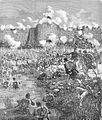
The capture of Sơn Tây, 16 December 1883

Capture of Nam Định, 19 July 1883.

French troops attack Nam Định fortress.
Unequal treaties[]
By 1862, the war was over and in the Treaty of Saigon Vietnam was forced to concede the three provinces in the south, which became the colony of French Cochinchina. The subsequent 1863 Treaty of Huế also saw the Vietnamese Empire open three ports to French trade, allowed free passage of French warships to Kampuchea (which led to the French protectorate of Kampuchea), allowed freedom for French missionaries, and gave France a large indemnity for the cost of the war. France did not intervene in the Christian-supported Vietnamese rebellion in Bắc Bộ (despite missionary urging) or the subsequent massacre of thousands of Christians after the rebellion, suggesting that persecution of Christians prompted the original intervention but military and political reasons drove continued colonization of Vietnam.[71]

Treaty of Saigon 1862

Vietnamese mission to Napoleon III (1863)

Vietnamese delegation to France in 1863 for peace treaty negotiation, Head of foreign minister Phan Thanh Giản (first row,middle).

Admiral Amédée Courbet and Harmand at Huế, August 1883

Signing of the Treaty of Huế, 25 August 1883

French propaganda painting in Hanoi, 1942
In the following decades Vietnam was gradually absorbed under French control. Further unequal treaties followed. The Second Treaty of Saigon in 1874 reiterated the stipulations of the previous treaty. When both China and France claimed sovereignty over Vietnamese territory, France deemed the treaty unfulfilled and occupied Hanoi in 1882. The 1883 Treaty of Huế led to the rest of Vietnam becoming French protectorates, divided into the Protectorates of Annam and Tonkin. The terms were however considered overly harsh in French diplomatic circles and never ratified in France. The following 1884 Treaty of Huế provided a softened version of the previous treaty.[71] The 1885 Treaty of Tientsin, which reaffirmed the 1884 Tientsin Accord and ended the Sino-French War, confirmed Vietnam's status as French protectorates and severed Vietnam's tributary relationship with the Qing dynasty by requiring that all of Vietnam's foreign affairs be conducted through France.[72]
After this the Nguyễn dynasty only nominally ruled the two French protectorates. Annam and Tonkin were combined with Cochinchina and the neighboring Cambodian protectorate in 1887 to form the Union of French Indochina, of which they became administrative components.[71]
French rule also added new ingredients to Vietnam's cultural stew: Catholicism and a Latin-based alphabet. The spelling used in the Vietnamese transliteration was Portuguese, because the French relied on a dictionary compiled earlier by a Portuguese cleric.[71]
World War I[]
While seeking to maximize the use of Indochina's natural resources and manpower to fight World War I, France cracked down on Vietnam's patriotic mass movements. Indochina (mainly Vietnam) had to provide France with 70,000 soldiers and 70,000 workers, who were forcibly drafted from villages to serve on the French battlefront. Vietnam also contributed 184 million piastres in loans and 336,000 tons of food.
These burdens proved heavy, since agriculture experienced natural disasters from 1914 to 1917. Lacking a unified nationwide organization, the vigorous Vietnamese national movement failed to use the difficulties France had as a result of war to stage significant uprisings.
In May 1916, sixteen-year-old emperor Duy Tân escaped from his palace to participate in an uprising of Vietnamese troops. The French were informed of the plan, and its leaders were arrested and executed. Duy Tân was deposed and exiled to the island of Réunion in the Indian Ocean.
World War II[]
Nationalist sentiment intensified in Vietnam (especially during and after the First World War), but uprisings and tentative efforts failed to obtain concessions from the French. The Russian Revolution greatly impacted 20th-century Vietnamese history.

Emperor Bảo Đại gives the royal sword to the representative of the Democratic Republic of Vietnam in abdication ceremony in 30/8/1945.

Company of Vietnamese troops parading for ceremonial investiture with decorations at Etampes in World War I.
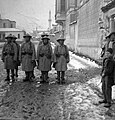
Vietnamese tirailleurs of the 2ème battalion in Korçë, Albania, January 1917.
For Vietnam, the outbreak of World War II on 1 September 1939 was as decisive as the 1858 French seizure of Đà Nẵng. The Axis power of Japan invaded Vietnam on 22 September 1940, attempting to construct military bases to strike against Allied forces in Southeast Asia. This led to a period of Indochina under Japanese occupation with cooperation of the collaborationist Vichy French, who still retained administration of the colony. During this time the Viet Minh, a communist resistance movement, developed under Ho Chi Minh from 1941, with allied support. During a 1944–1945 famine in northern Vietnam, over one million people starved to death.
In March 1945, after the liberation of France in Europe and heavy setbacks in the war. In a last ditch effort to gather support, the Japanese overthrew the French administration, imprisoned their civil servants and proclaimed independence for Cambodia, Laos and Vietnam, which became the Empire of Vietnam with Bảo Đại as its Emperor.[5][6] The Empire of Vietnam was a puppet state of the Empire of Japan.[5] After the Surrender of Japan, Bảo Đại abdicated on 25 August 1945 while the Viet Minh launched the August Revolution.[73]
This ended the 143-year reign of the Nguyễn dynasty.
National administration[]
Government[]
Emperor[]

Imperial seal, decorated with a dragon, and its imprint against a red background

Imperial Crown
The Nguyễn dynasty retained the bureaucratic and hierarchic system of previous dynasties. The emperor was the head of state who wielded absolute authority. Under the emperor was the Ministry of Interior (which worked on papers, royal messages and recording) and four Grand Secretariats (Vietnamese: Tứ trụ Đại thần), later renamed the Ministry of Secret Council.[74][75][76]
The Emperor of the Nguyễn dynasty was an absolutist ruler, which means he was both the head of state and the head of government.[77] The in 1812 declared the Vietnamese monarch as the universal ruler of all Vietnam; using the Confucian concept Mandate of Heaven to provide monarchs absolute power. Their reign and popular images were judged based on how prosperous the livelihood (民生, dân sinh) of the people and the Confucian concept of chính danh (rectification of names), according to the Confucian biblical Analects, everything has to stay in its right order.[78][79] Gia Long also perceived the ancient Chinese conception of Hua-yi (Hoa-Di in Vietnamese) and in 1805 he confessed his Empire as Trung Quốc (中國, "the Middle Kingdom"), the Vietnamese term which often refers to China but now was taken by Gia Long to emphasis his Son of Heaven status and the devaluation of China.[80][81] Following next decades, Confucianism and the Mandate of Heaven theory gradually lost their positions within the Vietnamese officials and intellectuals. When the fourth emperor, Tự Đức, ceded Southern Vietnam to France and called all Southern officials to give up arms, many ignored, disobeyed the Son of Heaven, and continued to fight against invaders. Many dissents viewed him as surrendering and frightened of France. Rebellions against Tự Đức erupted every year from 1860 until he died in 1883.[82]
A dual theory of sovereignty existed in Vietnam. All the Nguyễn monarchs were addresses as hoàng đế (黃帝, Sino-Vietnamese title for "Emperor") in the court while referring himself the first person honorific trẫm (he who give the order). They also used the concept of thiên tử (天子, "Son of Heaven", which is borrowed from China) to demonstrate that the ruler was descended and commissioned by heaven to rule the kingdom.[78] However, in most cases, Nguyen rulers were formally called vua (君, the Vietnamese title for "monarch" or " sovereign ruler") by the ordinary Vietnamese folks.[83][84] The concept of a divine Son of Heaven has not been dogmatically practiced, and the monarch's divinity was not absolute due to the dual theory. For example, Xu Jiyu, a Chinese geographer, reported that the bureaucrats in the Vietnamese court sat down and even felt free to search themselves for body lice during the court audiences. Gia Long once told the son of J. B. Chaigneau, one of his advisors, that the use of Son of Heaven in Vietnam was an "absurdity" and "at least in mixed Vietnamese-European Company."[84] Once the young crown prince being chosen to succeed, his obligation was to be filial with parents, being well-educated in politics and classics, internalise the morals and ethics of a ruler.[85]
After the 1884 treaty of Huế was signed the Nguyễn dynasty became two protectorates of France and the French installed their own administrators.[86] Although the Emperors of the Nguyễn dynasty were still nominally in control of the protectorates of Annam and Tonkin, the Resident-Superior of Annam gradually gained more influence over the imperial court in Huế.[86] In 1897 the Resident-Superior was granted the power to appoint the Nguyễn dynasty Emperors and presided over the meetings of the Viện cơ mật.[86] These moves incorporated French officials directly into the administrative structure of the Imperial Huế Court and further legitimised French rule in the legislative branch of the Nguyễn government.[86] From this period onwards any imperial edicts issued by the Emperors of Đại Nam had to be confirmed by the Resident-Suoerior of Annam giving him both legislative and executive power over the Nguyễn government.[86]
In the year 1898 the federal government of French Indochina took over the financial and property management duties of the Nguyễn dynasty's imperial court meaning that the Nguyễn dynasty Emperor (at the time Thành Thái) became a salaried employee of the Indochinese colonial structure, reducing their power to being only a civil servant of the Protectorate government.[86] The Resident-Superior of Annam also took over the management of provincial mandarins and was a member of the Supreme Council (Conseil supérieur) of the Government-General of French Indochina.[86]
Civil service and bureaucracy[]

Nguyễn dynasty mandarins in royal palace

Royal guards in Imperial palace

Nguyen dynasty's eunuch.

Emperor Khai Dinh on throne and cabinet

Mandarins bow to welcome the visit of emperor Bảo Đại to the ancestral tombs of Nguyễn Clan in Thanh Hóa province, 4/11/1932.
| Rank | Civil position | Military position |
|---|---|---|
| Upper first rank (Bậc trên nhất phẩm) | Imperial Clan Court (Tông Nhân Phủ, Tôn nhân lệnh) Three Ducal Ministers (Tam công): * Grand Preceptor (Thái sư) * Grand Tutor (Thái phó) * Grand Protector (Thái bảo) |
Same |
| First senior rank (Chánh nhất phẩm) | Left Right Imperial Clan Court (Tôn nhân phủ, Tả Hữu tôn chính") Three Vice-Ducal Ministers (Tam Thiếu) * Vice Preceptor (Thiếu sư) * Vice Tutor (Thiếu phó) * Vice Protector (Thiếu bảo) |
Same |
| First junior rank (Tòng nhất phẩm) | Council of State (Tham chính viện) House of Councillors (Tham Nghị viện) Grand Secretariat (Thị trung Đại học sĩ) |
Banner Unit Lieutenant General, General-in-Chief, Provincial Commander-in-Chief |
| Second senior rank (Chánh nhị phẩm) | 6 ministries (Lục bộ): * Ministry of Personnel (Bộ Lại) * Ministry of Rites (Bộ Lễ) * Ministry of Justice (imperial China) (Bộ Hình) * Ministry of Finance (Bộ Hộ) * Ministry of Public Works (Bộ Công) * Ministry of Defense (Bộ Binh) Supreme Censorate (Đô sát viện, Tả Hữu Đô ngự sử) |
Banner Captain General, Commandants of Divisions, Brigade General |
| Second junior rank (Tòng nhị phẩm) | 6 Ministerial Advisors (Lục bộ Tả Hữu Tham tri) Grand coordinator and provincial governor (Tuần phủ) Supreme Vice-Censorate (Đô sát viện, Tả Hữu Phó đô ngự sử) |
Major General, Colonel |
| Third senior rank (Chánh tam phẩm) | Senior Head of 6 Ministries (Chánh thiêm sự) Administration Commissioner (Cai bạ) Surveillance Commissioner (Ký lục) State Auxiliary Academician of Secretariat (Thị trung Trực học sĩ) Court Auxiliary Academician (Trực học sĩ các điện) Court academician (Học sĩ các điện) Provincial governor (Hiệp trấn các trấn) |
Brigadiers of Artillery & Musketry, Brigadier of Scouts, Banner Division Colonel |
| Third junior rank (Tòng tam phẩm) | Junior Head of Six Ministries (Thiếu thiêm sự) Senior Palace Administration Commissioner (Cai bạ Chính dinh) Chargé d'affaires (Tham tán) Court of Imperial Seals (Thượng bảo tự) General Staff (Tham quân) |
Banner Brigade Commander |
| Fourth senior rank (Chánh tứ phẩm) | Provincial Education Commissioner of Guozijian (Quốc tử giám Đốc học) Head of six ministries (Thiếu thiêm sự) Junior Court of Imperial Seals (Thượng bảo thiếu Khanh) Grand Secretaries (Đông các học sĩ) Administration Commissioner of Trường Thọ palace (Cai bạ cung Trường Thọ) Provincial Advisor to Defense Command Lieutenant Governor (Tham hiệp các trấn) |
Lieutenant Colonel of Artillery, Musketry & Scouts Captain, Police Major |
| Fourth junior rank (Tòng tứ phẩm) | Provincial Vice Education Commissioner of Guozijian (Quốc tử giám phó Đốc học), Prefect (Tuyên phủ sứ), | Captain, Assistant Major in Princely Palaces |
| Fifth senior rank (Chánh ngũ phẩm) | Inner Deputy Supervisors of Instruction at Hanlin Institutes, Sub-Prefects | Police Captain, Lieutenant or First Lieutenant |
| Fifth junior rank (Tòng ngũ phẩm) | Assistant Instructors and Librarians at Imperial and Hanlin Institutes, Assistant Directors of Boards and Courts, Circuit Censors | Gate Guard Lieutenants, Second Captain |
| Sixth senior rank (Chánh lục phẩm) | Secretaries & Tutors at Imperial & Hanlin Institutes, Secretaries and Registrars at Imperial Offices, Police Magistrate | Bodyguards, Lieutenants of Artillery, Musketry & Scouts, Second Lieutenants |
| Sixth junior rank (Tòng lục phẩm) | Assistant Secretaries in Imperial Offices and Law Secretaries, Provincial Deputy Sub-Prefects, Buddhist & Taoist priests | Deputy Police Lieutenant |
| Seventh senior rank (Chánh thất phẩm) | None | City Gate Clerk, Sub-Lieutenants |
| Seventh junior rank (Tòng thất phẩm) | Secretaries in Offices of Assistant Governors, Salt Controllers & Transport Stations | Assistant Major in Nobles' Palaces |
| Eighth senior rank (Chánh bát phẩm) | None | Ensigns |
| Eighth junior rank (Tòng bát phẩm) | Sub-director of Studies, Archivists in Office of Salt Controller | First Class Sergeant |
| Ninth senior rank (Chánh cửu phẩm) | None | Second Class Sergeant |
| Ninth junior rank (Tòng cửu phẩm) | Prefectural Tax Collector, Deputy Jail Warden, Deputy Police Commissioner, Tax Examiner | Third Class Sergeant, Corporal, First & Second Class Privates |
Taxes[]
This section does not cite any sources. (September 2018) |
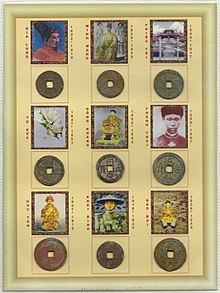
Vietnam's monetary subunit was the quan (貫). One quan equaled 10 coins, equivalent to ₫600. Officials received the following taxes (Vietnamese: thuế đầu người):
- First senior rank (Chánh nhất phẩm): 400 quan; rice: 300 kg; per-capita tax: 70 quan
- First junior rank (Tòng nhất phẩm): 300 quan; rice: 250 kg; tax: 60 quan
- Second senior rank (Chánh nhị phẩm): 250 quan; rice: 200 kg; tax: 50 quan
- Second junior rank (Tòng nhị phẩm): 180 quan; rice: 150 kg; tax: 30 quan
- Third senior rank (Chánh tam phẩm): 150 quan; rice: 120 kg; tax: 20 quan
- Third junior rank (Tòng tam phẩm): 120 quan; rice: 90 kg; tax: 16 quan
- Fourth senior rank (Chánh tứ phẩm): 80 quan; rice: 60 kg; tax: 14 quan
- Fourth junior rank (Tòng tứ phẩm): 60 quan; rice: 50 kg; tax: 10 quan
- Fifth senior rank (Chánh ngũ phẩm): 40 quan; rice: 43 kg; tax: 9 quan
- Fifth junior rank (Tòng ngũ phẩm): 35 quan; rice: 30 kg; tax: 8 quan
- Sixth senior rank (Chánh lục phẩm): 30 quan; rice: 25 kg; tax: 7 quan
- Sixth junior rank (Tòng lục phẩm): 30 quan; rice: 22 kg; tax: 6 quan
- Seventh senior rank (Chánh thất phẩm): 25 quan; rice: 20 kg; tax: 5 quan
- Seventh junior rank (Tòng thất phẩm): 22 quan; rice: 20 kg; tax: 5 quan
- Eighth senior rank (Chánh bát phẩm): 20 quan; rice: 18 kg; tax: 5 quan
- Eighth junior rank (Tòng bát phẩm): 20 quan; rice: 18 kg; tax: 4 quan
- Ninth senior rank (Chánh cửu phẩm): 18 quan; rice: 16 kg; tax: 4 quan
- Ninth junior rank (Tòng cửu phẩm): 18 quan; rice: 16 kg; tax: 4 quan
Political Organization[]

Privy council of Nguyen Dynasty (Cơ Mật Viện: 機密院).

Ministry of Rites of Nguyen Dynasty (Lễ Bộ: 禮部).

Ministry of administration of Nguyen Dynasty (Lại Bộ: 吏部).

Ministry of Finance of Nguyen Dynasty (Hộ Bộ: 戸部).

Ministry of Public Works (Công Bộ: 工部).

Ministry of Laws (Hình Bộ: 刑部).
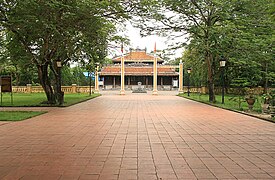
Imperial Academy, Huế under Ministry of Education (Học Bộ: 学部).
The headquarter of the Privy council.

Phục mạng ceremony when mandarin receive the edict from the Emperor.
Education system[]

Candidates on the way to examination school (1897).
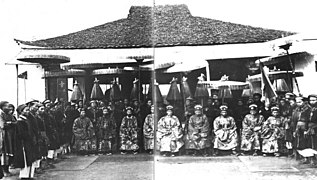
The Imperial examination council.
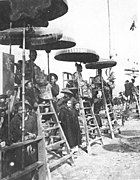
Examinator from ministry of education in Nam Định (1897).

Examinator Tran-Si-Trac (1897).
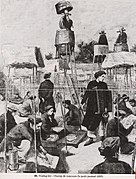
Exam supervising from the top (1897).

Graduates receive Emperor's feast for passing the exams in Nam Định (1897).

Graduates pay gratitude for their own teachers (1897).

Graduates pay gratitude at the Confucian temple (1897).
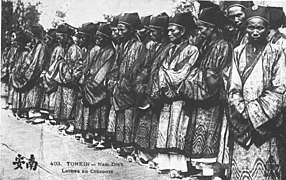
New graduates receive the graduation uniforms from Emperor in Nam Định (1897).

Candidates checking their names on result boards.

French Indochina governor Paul Doumer joins the honour ceremony of graduates.
Pension[]
When mandarins retired, they could receive one hundred to four hundred quan from the emperor. When they died, the royal court provided twenty to two hundred quan for a funeral.[citation needed]
Administrative divisions[]
Under Gia Long[]
During the reign of Gia Long, the kingdom was divided into twenty-three quasi-militant protectorates trấn and four military departments doanh.[87] Each protectorate, besides having their own separated regional governments, were under patrol of one greater, powerful unit called Overlord of Citadel, or the Viceroy. For examples, the northern protectorates had Bắc thành Tổng trấn (Viceroy of Northern Protectorates) in Hanoi, and southern protectorates had Gia Định thành Tổng trấn (Viceroy of Gia Định Protectorates) resides in Saigon.[88] Two famously viceroys during Gia Long's reign were Nguyễn Văn Thành (Hanoi) and Lê Văn Duyệt (Saigon). By 1802, these were:
- 16 protectorates under joint-governance from the Viceroys.
- Sơn Nam Thượng (Hanoi)
- Sơn Nam Hạ (Nam Định)
- Sơn Tây
- Kinh Bắc (Bắc Ninh)
- Hải Dương
- Tuyên Quang
- Hưng Hoá
- Cao Bằng
- Lạng Sơn
- Thái Nguyên
- Quảng Yên
- Gia Định or Phiên An
- Biên Hoà
- Vĩnh Thanh (later became Vĩnh Long and An Giang
- Định Tường (Bến Tre)
- Hà Tiên
- 7 Central protectorates
- Thanh Hoá
- Nghệ An
- Quảng Nghĩa (Quảng Ngãi)
- Bình Định
- Phú Yên
- Bình Hoà (Khánh Hoà)
- Bình Thuận
- 4 departments surrounding Huế, directly ruled by Gia Long.
- Quảng Đức
- Quảng Bình
- Quảng Trị
- Quảng Nam
Minh Mạng and later[]
In 1831, Minh Mạng reorganised his kingdom by converting all these protectorates into 31 provinces (tỉnh). Each province had a series of smaller jurisdictions: the prefecture (phủ), the subprefecture (châu, in areas whereas having a significant population of ethnic minorities). Under prefecture and subprefecture, there was the district (huyện), the canton (tổng). Under district and canton, the bundle of hamlets around one common religious temple or social factor point, the village làng or the commune (xã) was the lowest administrative unit, which one respected person nominally took care of village administrative, which called lý trưởng.[89]
Two nearby provinces were combined into a pair. Every pair had a governor-general (Tổng đốc) and a governor (Tuần phủ).[90] Frequently, there were twelve governor-generals and eleven governors, although, in some periods, the Emperor would appoint a "commissioner in charge of patrolled borderlands" (kinh lược sứ) that supervising entire northern of the southern part of the kingdom.[91] In 1803, Vietnam had 57 prefectures, 41 subprefectures, 201 districts, 4,136 cantons and 16,452 villages, and then by 1840s its had been increased to 72 prefectures, 39 subprefectures and 283 districts, which an average 30,000 people per district.[89] Cambodia had been absorbed into the Vietnamese administrative system, bore the name Tây Thành Province from 1834 to 1845.[92] With areas having minority groups like Tày, Nùng, Mèo (Hmong people), Mường, Mang and Jarai, the Huế court imposed the co-existing tributary and quasi-bureaucratic governance system, while allowing these people to have their own local rulers and autonomy.[93]

In 1832, there were:
- Three regions and 31 provinces (encompassed modern-day Vietnam):[94]
- Client/dependent territories:[95]
- Luang Phrabang
- Vientine
- Cambodia
- Jarai chiefdoms
- Chief cities:
- Huế, capital city, population (1880): 30,000
- Hanoi, major city, population (1880): 120,000
- Saigon, major city, population (1880): 100,000
Economy[]
Society[]
Culture and Cultural Discrimination[]

The Vietnamese at one point viewed cultures that were "non-Chinese" as barbaric and called themselves the Central Kingdom.[96] This occurred after Vietnam had sent a delegate to Beijing, whereupon a diplomatic disaster caused Vietnam to view other "non-Chinese" as barbaric following Qing viewpoints.[97] By the Nguyen dynasty the Vietnamese themselves were ordering Cambodian Khmer to adopt Vietnamese culture by ceasing "barbarous" habits like cropping hair and ordering them to grow it long besides making them replace skirts with trousers.[98] Han Chinese Ming dynasty refugees numbering 3,000 came to Vietnam at the end of the Ming dynasty. They opposed the Qing dynasty and were fiercely loyal to the Ming dynasty. Vietnamese women married these Han Chinese refugees since most of them were soldiers and single men. They did not wear Manchu hairstyle unlike later Chinese migrants to Vietnam during the Qing dynasty.[99]
Subjugation of Champa[]
Minh Mang engineered the final conquest of the Champa Kingdom after the centuries-long Cham–Vietnamese wars. Cham Muslim leader Katip Suma was educated in Kelantan, returning to Champa to declare a jihad against the Vietnamese after Minh Mang's annexation of the region.[70][100][101][102] The Vietnamese forced Champa's Muslims to eat lizard and pork and its Hindus to eat beef to assimilate them into Vietnamese culture.[103]
Vietnamisation of ethnic minorities[]

Minh Mạng sinicised ethnic minorities (such as Cambodians), claimed the legacy of Confucianism and China's Han dynasty for Vietnam, and used the term "Han people" (漢人, Hán nhân) to refer to the Vietnamese.[104][105] According to the emperor, "We must hope that their barbarian habits will be subconsciously dissipated, and that they will daily become more infected by Han [Sino-Vietnamese] customs."[106] These policies were directed at the Khmer and hill tribes.[107] Nguyen Phuc Chu had referred to the Vietnamese as "Han people" in 1712, distinguishing them from the Chams.[108] The Nguyen lords established colonies after 1790. Gia Long said, "Hán di hữu hạn" (漢 夷 有 限, "The Vietnamese and the barbarians must have clear borders"), distinguishing the Khmer from the Vietnamese.[109] Minh Mang implemented an acculturation policy for minority non-Vietnamese peoples.[110] "Thanh nhân" (清 人 referring to the Qing dynasty) or "Đường nhân" (唐人 referring to the Tang dynasty) were used to refer to ethnic Chinese by the Vietnamese, who called themselves "Hán dân" (漢 民) and "Hán nhân" (漢人 referring to the Han dynasty) during 19th-century Nguyễn rule.[111] Since 1827, descendants of Ming dynasty refugees were called Minh nhân (明人) or Minh Hương (明 鄉) by Nguyễn rulers, to distinguish with ethnic Chinese.[112] Minh nhân were treated as Vietnamese since 1829.[113][114]:272 They were not allowed to go to China, and also not allowed to wear the Manchu queue.[115]
Costume[]
The Nguyễn dynasty popularized Chinese Qing clothing.[116][117][118][119][120][121] Trousers were adopted by female White H'mong speakers,[122] replacing their traditional skirts.[123] The Qing Chinese Qibao tunics and trousers were worn by the Vietnamese. The áo dài was developed in the 1920s, when compact, close-fitting tucks were added to similar Qibao "Ao Tu Than".[124] Chinese Qipao trousers and tunics were ordered by lord Nguyễn Phúc Khoát during the 18th century, replacing traditional Vietnamese Hanfu-style clothes.[125] Although the Chinese trousers and tunic were mandated by the Nguyen government, skirts were worn in isolated north Vietnamese hamlets until the 1920s.[126] Chinese style clothing was ordered for the Vietnamese military and bureaucrats by Nguyễn Phúc Khoát.[127]
An 1841 polemic, "On Distinguishing Barbarians", was based on the Qing sign "Vietnamese Barbarians' Hostel" (越夷會館) on the Fujian residence of Nguyen diplomat and Hoa Chinese (李文馥).[128][129][130][131] It argued that the Qing did not subscribe to the neo-Confucianist texts from the Song and Ming dynasties which were learned by the Vietnamese,[132] who saw themselves as sharing a civilization with the Qing.[133] This event triggered a diplomatic disaster. The consequence was that non-"Han Chinese highland tribes" and other non-Vietnamese peoples living near (or in) Vietnam were called "barbarian" by the Vietnamese imperial court.[134][135] The essay distinguishes the Yi and Hua, and mentions Zhao Tuo, Wen, Shun and Taibo.[136] Kelley and Woodside described Vietnam's Confucianism.[137]
Emperors Minh Mạng, Thiệu Trị and Tự Đức, were opposed to French involvement in Vietnam, and tried to reduce the country's growing Catholic community. The imprisonment of missionaries who had illegally entered the country was the primary pretext for the French to invade (and occupy) Indochina. Like Qing China, a number of incidents involved other European nations during the 19th century.
Religion[]
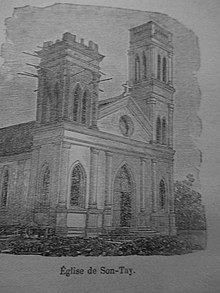
Although the previous Nguyễn lords were faithful Buddhists, Gia Long was not a Buddhist. He adopted Confucianism and actively prohibited Buddhism. Scholars, elites, and officials attacked Buddhist doctrine and criticized them as superstitious and useless. The third emperor, Thieu Tri, elevated Confucianism as the true religion and while regarding Buddhism as superstition.[138] Building new Buddhist pagoda and temple were forbidden. Buddhist clergies and nuns were forced to join public works in order to suppress the Buddhism religion, its deities and promote Confucianism as the sole dominant belief of the society. However, such embracing a Sinic Confucian culture among the Vietnamese populace whom lived amidst a Southeast Asian infrastructure, pushed the distance between the population and the court far away.[139] Buddhism still made it prevailed in society and penetrating the royal palace. Empress mother, queens, princess, and concubines were devout Buddhists, despite the patriarchy prohibition.
Confucianism itself was the ideology of the Nguyen court, also provided the basic core of classical education and civil examination every year. Gia Long pursued Confucianism to create and maintain a conservative society and social structures. Confucian rituals and ideas were circulations based within ancient Confucian teaching such as The Analects and Spring and Autumn Annals in Vietnamese-script collections.[140] The court rigidly imported these Chinese books from Chinese merchants. Confucian rituals such as cầu đảo (offering heaven for wind and rain during a drought) that the emperor and court officials perform for wishing heaven to rain down his kingdom.[141] If the offer went successful, they had to conduct lễ tạ (thanksgiving ritual) to heaven. In addition, the emperor believed that holy spirits and natural goddesses of his country can also make rain. In 1804, Gia Long built the Nam Hải Long Vương Temple (Temple of Dragon king of Southern ocean) in Thuận An, northeast of Hue in his faithfulness to the spirit of Thuận An (Thần Thuận An), the place where most of cầu đảo ritual was performed.[142][143] His successor, Minh Mang, continued to build several temples dedicated to the Vũ Sư (rainmaking goddess) and altars for Thần Mây (Cloud Goddess) and Thần Sấm (Thunder Goddess).[144]
Nguyen Truong To, a prominent Catholic and reformist intellectual, launched an attack on Confucian structures in 1867 as decadent. He wrote to Tu Duc: "the evil that has been brought on China and on our country by the Confucian way of life." He criticized the court's Confucian education as dogmatic and unrealistic, promoted for his education reform.[145][146]
During Gia Long's years, Catholicism was peacefully worshipped without any restriction. Began with Minh Mạng, who considered Christianity as a heterodox religion for its rejection of ancestor worship, the important belief of the Vietnamese monarchy. After reading the Bible (Old and New Testament), he considered the Christianity religion irrational and ridiculous, and praised Tokugawa Japan for its notorious policies on Christians. Minh Mạng also was influenced by anti-Christian propaganda written by Vietnamese Confucian officials and literati, which described the mixing of men and women and liberal society among the Church. The most thing he worried about Christianity and Catholicism was writing texts that proved that Christianity was a means for Europeans to take over foreign countries. He also praised the anti-Christian policy in Japan.[147] Churches were destroyed and many Christians were imprisoned. The persecution got intense during the reign of his grandson Tu Duc, when most of the state efforts were to annihilate Vietnamese Christianity. Unironically, even during the height of the anti-Catholic campaign, many Catholic scholars were still permitted to hold high positions in the royal court.
After a royal edict in late 1862, Catholicism was officially recognised and worshippers obtained state protection. It is estimated that late-19th century Vietnam had about 600,000 to 700,000 Catholic Christians.
Demography[]

Before the French conquest, the Vietnamese population was very sparse due to the agricultural backbones economy of the country. The population in 1802 was 6.5 million people and had only grown to 8 million by 1840.[148] Rapid industrialization after the 1860s ushered in massive population growth and rapid urbanization in the late 19th century. Many peasants left tenant farms and poured into cities, they were hired by French-owned factories. By 1880 the Vietnamese were estimated back then as high as 18 million people,[149] while modern estimates by Angus Maddison have suggested a lower figure of 12.2 million people.[150] Vietnam under the Nguyễn dynasty was always a multiethnic complex. Nearly 80% percent of the Empire's population were ethnic Vietnamese (called Annamites then),[151] whom language belonged to the Mon-Khmer (Mon—Annamite then) stock,[152] and the rest were Cham, Chinese, Khmer, Muong, Tày (called Tho then), and other 50 ethnic minorities such as the Mang, Jarai, Yao.[153]
The Annamites are distributed across the lowland of the country from Tonkin to Cochichina. The Chams live in central Vietnam and the Mekong Delta. The Chinese particularly concentrated in urbanised areas such as Saigon, Cho Lon, and Hanoi.[154] The Chinese tended to be divided into two groups called Minh Hương (明鄉) and Thanh nhân. (清人)[155] The Minh hương were Chinese refugees that had migrated and settled down in Vietnam earlier during the 17th century, who married with Vietnamese women, had been substantially assimilated to local Vietnamese and Khmer populaces, and loyal to the Nguyen,[156] compared to the Thanh nhân that recently arrived in Southern Vietnam, dominated the rice trade. During the reign of Minh Mạng, a restriction against the Thanh nhân was issued in 1827, Thanh nhân could not access to the state bureaucracy and had to be integrated into Vietnamese population like the Minh Hương.[157]
The Muongs inhabited on the hills west of the Red River Delta, although subordinate to the central authority, they were also permitted to bear arms, a privilege not accorded to any other subjects of the court of Hue. The Tay and the Mang live in the northern highlands of Tonkin, both submitted to Hue court along with taxes and tribute, but are allowed to have their hereditary chiefs.[158]
Photography[]

The first photographs of Vietnam were taken by Jules Itier in Danang, in 1845.[159] The first photos of the Vietnamese were taken by Fedor Jagor in November 1857 in Singapore.[160] Due to the forbidden contact to foreigners, photography returned to Vietnam again during the French conquest and had shots taken by during the French invasion of Da Nang (September 1858).[161] Since the French seizure of Saigon in 1859, the city and southern Vietnam had been opening to foreigners, and photography entered Vietnam exclusively from France and Europe.[162]
Early photographers active in Vietnam were:
- [163] (1831–95)
- [164] (1834–75)
- [165] (?–1874)
- John Thomson[166]
- Wilhelm Burger[167] (1844–1920)
- Émile Gsell[168] (1837–1869)
Commercial studios:
- [169] (fl. 1863–1867)
- [170] (fl. 1864)
- [171] (f. 1867–1872)
- Đặng Huy Trứ's Cam Hieu Duong Photography Shop[172] (fl. 1869–1874)
- [173] (f. 1870)
- [174]
- [175] (fl. 1877–1881)
Military[]
Galleries[]

1884 drawing of a marriage ceremony in Tonkin

Nguyễn-dynasty elephant parade in Huế
Imperial family[]
| Imperial family of the Nguyễn dynasty | |
|---|---|
 | |
| Country | |
| Founded | 1558 |
| Final ruler | Bảo Đại |
| Titles |
|
| Traditions | Buddhism, Confucianism and Catholicism |
| Deposition | 1945 (Abdication of Bảo Đại) |
| Cadet branches | Tôn Thất |
The House of Nguyễn Phúc (Nguyen Gia Mieu) had historically been founded in the 14th century in Gia Mieu village, Thanh Hoa Province, before they came to rule southern Vietnam from 1558 to 1777, then became the ruling dynasty of the entire Vietnam. Traditionally, the family traces themselves to Nguyễn Bặc (?–979), the first duke of Dai Viet. Princes and male descendants of Gia Long are called Hoàng Thân, while male lineal descendants of previous Nguyen lords are named Tôn Thất. Grandsons of the emperor were Hoàng tôn. Daughters of the emperor were called Hoàng nữ, and always earned the title công chúa (princess).
Their succession practically is according to the law of primogeniture, but sometimes conflicted. The first succession conflict arose in 1816 when Gia Long was designing for an heir. His first prince Nguyễn Phúc Cảnh died in 1802. As a result, two rival factions emerged, one support Nguyễn Phúc Mỹ Đường, the eldest son of Prince Cảnh, as the crown prince, while other support Prince Đảm (later Minh Mang).[176] The second conflict was the 1847 succession when two young princes Nguyễn Phúc Hồng Bảo and Hồng Nhậm were dragged by the ill-failing emperor Thieu Tri as a potential heir. At first, Thieu Tri apparently chose Prince Hồng Bảo because he was older, but after hearing advice from two regents and Nguyễn Tri Phương, he revised the heir at last minute and choose Hồng Nhậm as the crown prince.[177]
Emperors[]
The following list is the emperors' era names, which have meaning in Chinese and Vietnamese. For example, the first ruler's era name, Gia Long, is the combination of the old names for Saigon (Gia Định) and Hanoi (Thăng Long) to show the new unity of the country; the fourth, Tự Đức, means "Inheritance of Virtues"; the ninth, Đồng Khánh, means "Collective Celebration".
| Portrait/Photo | Temple name | Posthumous name | Personal name | Lineage | Reign | Regnal name | Tomb | Events |
|---|---|---|---|---|---|---|---|---|

|
Thế Tổ | Khai Thiên Hoằng Đạo Lập Kỷ Thùy Thống Thần Văn Thánh Vũ Tuấn Đức Long Công Chí Nhân Đại Hiếu Cao Hoàng Đế | Nguyễn Phúc Ánh | Nguyễn lords | 1802–20 (1) | Gia Long | Thiên Thọ lăng | Defeated the Tây Sơn and unified Vietnam. |

|
Thánh Tổ | Thể Thiên Xương Vận Chí Hiếu Thuần Đức Văn Vũ Minh Đoán Sáng Thuật Đại Thành Hậu Trạch Phong Công Nhân Hoàng Đế | Nguyễn Phúc Đảm | Son | 1820–41 (2) | Minh Mệnh | Hiếu Lăng | Annexed Cambodia after the Siamese–Vietnamese War (1831–1834). Annexed Muang Phuan after the . Suppressed the Lê Văn Khôi revolt. Annexed the remaining Panduranga kingdom after the Ja Thak Wa uprising, renamed the country Đại Nam (Great South), suppressed Christianity. |

|
Hiến Tổ | Thiệu Thiên Long Vận Chí Thiện Thuần Hiếu Khoan Minh Duệ Đoán Văn Trị Vũ Công Thánh Triết Chượng Chương Hoàng Đế | Nguyễn Phúc Miên Tông | Son | 1841–47 (3) | Thiệu Trị | Xương Lăng | Carried out policies of isolationism. Pulling troops from Cambodia. |

|
Dực Tông | Thể Thiên Hanh Vận Chí Thành Đạt Hiếu Thể Kiện Đôn Nhân Khiêm Cung Minh Lược Duệ Văn Anh Hoàng Đế | Nguyễn Phúc Hồng Nhậm | Son | 1847–83 (4) | Tự Đức | Khiêm Lăng | Suppressed Đoàn Hữu Trưng's rebellion. Facing French invasions. Ceded Cochinchina to France after the Cochinchina campaign. Fought against French invasions of 1873 and 1882–1883. |

|
Cung Tông | Huệ Hoàng Đế | Nguyễn Phúc Ưng Chân | Nephew (adopted son of Tự Đức) | 1883 (5) | Dục Đức | An Lăng | Three-day emperor (20–23 July 1883), deposed and poisoned by Tôn Thất Thuyết |
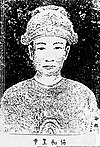
|
– | Văn Lãng Quận Vương | Nguyễn Phúc Hồng Dật | Uncle (son of Thiệu Trị) | 1883 (6) | Hiệp Hòa | Four-month emperor (30 July – 29 November 1883), poisoned by the order of Tôn Thất Thuyết. | |

|
Giản Tông | Thiệu Đức Chí Hiếu Uyên Duệ Nghị Hoàng Đế | Nguyễn Phúc Ưng Đăng | Nephew (son of Hiệp Hòa's brother) | 1883–84 (7) | Kiến Phúc | Bồi Lăng (within Khiêm Lăng) | Eight-month emperor (2 December 1883 – 31 July 1884). Signing of the Treaty of Huế (1884). |
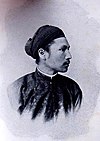
|
– | — | Nguyễn Phúc Ưng Lịch | Younger brother | 1884–85 (8) | Hàm Nghi | Thonac Cemetery, France | Resisting against French rule under the Cần Vương movement. Dethroned after one year, continuing his rebellion until captured in 1888 and exiled to Algeria until his death in 1943. |

|
Cảnh Tông | Hoằng Liệt Thống Thiết Mẫn Huệ Thuần Hoàng Đế | Nguyễn Phúc Ưng Kỷ | Older brother | 1885–89 (9) | Đồng Khánh | Tư Lăng | Suppress Hàm Nghi's Cần Vương movement |

|
– | Hoài Trạch Công | Nguyễn Phúc Bửu Lân | Cousin (son of Dục Đức) | 1889–1907 (10) | Thành Thái | An Lăng | Exiled to Réunion Island due to anti-French activities |

|
– | — | Nguyễn Phúc Vĩnh San | son | 1907–16 (11) | Duy Tân | An Lăng | Rebelled against the French and exiled to Réunion Island in 1916. |
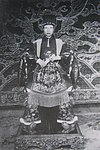
|
Hoằng Tông | Tự Đại Gia Vận Thánh Minh Thần Trí Nhân Hiếu Thành Kính Di Mô Thừa Liệt Tuyên Hoàng Đế | Nguyễn Phúc Bửu Đảo | Cousin (son of Đồng Khánh) | 1916–25 (12) | Khải Định | Ứng Lăng | Collaborated with the French, and was a political figurehead for French colonial rulers. Unpopular to the Vietnamese people. |

|
— | — | Nguyễn Phúc Vĩnh Thụy | Son | 1926–45 (13) | Bảo Đại | Cimetière de Passy, France | Head of the Empire of Vietnam under Japanese occupation during World War II; abdicated and transferred power to the Viet Minh in 1945, ending the Vietnamese monarchy. Installed as head of state of the State of Vietnam, ousted by Ngo Dinh Diem after the 1955 State of Vietnam referendum. |
After the death of Emperor Tự Đức (and according to his will), Dục Đức ascended to the throne on 19 July 1883. He was dethroned and imprisoned three days later, after being accused of deleting a paragraph from Tự Đức's will. With no time to announce his dynastic title, his era name was named for his residential palace.
Lineage[]
| 1 Gia Long 1802–1819 |
|||||||||||||
| 2 Minh Mệnh 1820–1840 |
|||||||||||||
| 3 Thiệu Trị 1841–1847 |
|||||||||||||
| 4 Tự Đức 1847–1883 |
Thoại Thái Vương | Kiên Thái Vương | 6 Hiệp Hoà 1883 | ||||||||||
| 5 Dục Đức 1883 |
9 Đồng Khánh 1885–1889 |
8 Hàm Nghi 1884–1885 |
7 Kiến Phúc 1883–1884 | ||||||||||
| 10 Thành Thái 1889–1907 |
12 Khải Định 1916–1925 |
||||||||||||
| 11 Duy Tân 1907–1916 |
13 Bảo Đại 1926–1945 |
||||||||||||
Note:
- Years are reigning years.
Family tree[]
Simplified family tree of the Nguyen Phuc dynasty:
- - Lords of Cochinchina (1550s–1777)
- - Emperors of the independent Vietnamese monarchy (1802–1883)
- - Emperors of French Annam and Tonkin/Emperor of Empire of Vietnam (1885–1945)
| hideNguyễn Phúc family tree | |||||||||||||||||||||||||||||||||||||||||||||||||||||||||||||||||||||||||||||||||||||||||||||||||||||||||||||||||||||||||||||||||||||||||||||||||||||||||||||||||||||||||||||||||||||||||||||||||||||||||||||||||||||||||||||||||||||||||||||||||||||||||||||||||||||||||||||||||||||||||||||||||||||||||||||||||||||||||||||||||||||||||||||||||||||||||||||||||||||||||||||||||||||||||||||||||||||||||||||||||||||||||||||||||||||||||||||||||||||||||||||||||||||||||||||||||||||||||||||||||||||||||||||||||||||||||||||||||||||||||||||||||||||||||||||||||||||||||||||||||||||||||||||||||||||||||||||||||||||||||||||||||||||||||||||||||||||||||||||||||||||||||||||||||||||||||||||||||||||||||||||||||||||||||||||||||||||||||||||||||||||||||||||||||||||||||||||||||||||||||||||||||||||||||||||||||||||||||||||||||||||||||||||||||||||||||||||||||||||||||||||||||||||||||||||||||||||||||||||||||||||||||||||||||||||||||||||||||||||||||||||||||||||||||||||||||||||||||||||||||||||||||||||||||||||||||||||||||||||||
|---|---|---|---|---|---|---|---|---|---|---|---|---|---|---|---|---|---|---|---|---|---|---|---|---|---|---|---|---|---|---|---|---|---|---|---|---|---|---|---|---|---|---|---|---|---|---|---|---|---|---|---|---|---|---|---|---|---|---|---|---|---|---|---|---|---|---|---|---|---|---|---|---|---|---|---|---|---|---|---|---|---|---|---|---|---|---|---|---|---|---|---|---|---|---|---|---|---|---|---|---|---|---|---|---|---|---|---|---|---|---|---|---|---|---|---|---|---|---|---|---|---|---|---|---|---|---|---|---|---|---|---|---|---|---|---|---|---|---|---|---|---|---|---|---|---|---|---|---|---|---|---|---|---|---|---|---|---|---|---|---|---|---|---|---|---|---|---|---|---|---|---|---|---|---|---|---|---|---|---|---|---|---|---|---|---|---|---|---|---|---|---|---|---|---|---|---|---|---|---|---|---|---|---|---|---|---|---|---|---|---|---|---|---|---|---|---|---|---|---|---|---|---|---|---|---|---|---|---|---|---|---|---|---|---|---|---|---|---|---|---|---|---|---|---|---|---|---|---|---|---|---|---|---|---|---|---|---|---|---|---|---|---|---|---|---|---|---|---|---|---|---|---|---|---|---|---|---|---|---|---|---|---|---|---|---|---|---|---|---|---|---|---|---|---|---|---|---|---|---|---|---|---|---|---|---|---|---|---|---|---|---|---|---|---|---|---|---|---|---|---|---|---|---|---|---|---|---|---|---|---|---|---|---|---|---|---|---|---|---|---|---|---|---|---|---|---|---|---|---|---|---|---|---|---|---|---|---|---|---|---|---|---|---|---|---|---|---|---|---|---|---|---|---|---|---|---|---|---|---|---|---|---|---|---|---|---|---|---|---|---|---|---|---|---|---|---|---|---|---|---|---|---|---|---|---|---|---|---|---|---|---|---|---|---|---|---|---|---|---|---|---|---|---|---|---|---|---|---|---|---|---|---|---|---|---|---|---|---|---|---|---|---|---|---|---|---|---|---|---|---|---|---|---|---|---|---|---|---|---|---|---|---|---|---|---|---|---|---|---|---|---|---|---|---|---|---|---|---|---|---|---|---|---|---|---|---|---|---|---|---|---|---|---|---|---|---|---|---|---|---|---|---|---|---|---|---|---|---|---|---|---|---|---|---|---|---|---|---|---|---|---|---|---|---|---|---|---|---|---|---|---|---|---|---|---|---|---|---|---|---|---|---|---|---|---|---|---|---|---|---|---|---|---|---|---|---|---|---|---|---|---|---|---|---|---|---|---|---|---|---|---|---|---|---|---|---|---|---|---|---|---|---|---|---|---|---|---|---|---|---|---|---|---|---|---|---|---|---|---|---|---|---|---|---|---|---|---|---|---|---|---|---|---|---|---|---|---|---|---|---|---|---|---|---|---|---|---|---|---|---|---|---|---|---|---|---|---|---|---|---|---|---|---|---|---|---|---|---|---|---|---|---|---|---|---|---|---|---|---|---|---|---|---|---|---|---|---|---|---|---|---|---|---|---|---|---|---|---|---|---|---|---|---|---|---|---|---|---|---|---|---|---|---|---|---|---|---|---|---|---|---|---|---|---|---|---|---|---|---|---|---|---|---|---|---|---|---|---|---|---|---|---|---|---|---|---|---|---|---|---|---|---|---|---|---|---|---|---|---|---|---|---|---|---|---|---|---|---|---|---|---|---|---|---|---|---|---|---|---|---|---|---|---|---|---|---|---|---|---|---|---|---|---|---|---|---|---|---|---|---|---|---|---|---|---|---|---|---|---|---|---|---|---|---|---|---|---|---|---|---|---|---|---|---|---|---|---|---|---|---|---|---|---|---|---|---|---|---|---|---|---|---|---|---|---|---|---|---|---|---|---|---|---|---|---|---|---|---|---|---|---|---|---|---|---|---|---|---|---|---|---|---|---|---|---|---|---|---|---|---|---|---|---|---|---|---|---|---|---|---|---|---|---|---|---|---|---|---|---|---|---|---|---|---|---|---|---|---|---|---|---|---|---|---|---|---|---|---|---|---|---|---|---|---|---|---|---|---|---|---|---|---|---|---|---|---|---|---|---|---|---|---|---|---|---|---|---|---|---|---|---|---|---|---|---|---|---|---|---|---|---|---|---|---|---|---|---|---|---|---|---|---|---|---|---|---|---|---|---|---|---|---|---|---|---|---|---|---|---|---|---|---|---|---|---|---|---|---|---|---|---|---|---|---|---|---|---|---|---|---|---|---|---|---|---|---|---|---|---|
| |||||||||||||||||||||||||||||||||||||||||||||||||||||||||||||||||||||||||||||||||||||||||||||||||||||||||||||||||||||||||||||||||||||||||||||||||||||||||||||||||||||||||||||||||||||||||||||||||||||||||||||||||||||||||||||||||||||||||||||||||||||||||||||||||||||||||||||||||||||||||||||||||||||||||||||||||||||||||||||||||||||||||||||||||||||||||||||||||||||||||||||||||||||||||||||||||||||||||||||||||||||||||||||||||||||||||||||||||||||||||||||||||||||||||||||||||||||||||||||||||||||||||||||||||||||||||||||||||||||||||||||||||||||||||||||||||||||||||||||||||||||||||||||||||||||||||||||||||||||||||||||||||||||||||||||||||||||||||||||||||||||||||||||||||||||||||||||||||||||||||||||||||||||||||||||||||||||||||||||||||||||||||||||||||||||||||||||||||||||||||||||||||||||||||||||||||||||||||||||||||||||||||||||||||||||||||||||||||||||||||||||||||||||||||||||||||||||||||||||||||||||||||||||||||||||||||||||||||||||||||||||||||||||||||||||||||||||||||||||||||||||||||||||||||||||||||||||||||||||||
Succession line[]
 Thiệu Trị (1801-1847)
Thiệu Trị (1801-1847)
 Tự Đức (1829-1883)
Tự Đức (1829-1883)- Kiên Thái Vương (1845-1876)
Images of the imperial family[]

Imperial Palanquin.
Stone sculptures outside the tomb of Minh Mạng.

Emperor Thành Thái (French protection period) in French Indochina riding a bicycle in a magazine issued on 22 January 1898.
Symbols[]
Flags[]
The Nguyễn dynasty's national flag or the Imperial flag first appeared during the reign of Gia Long. It was a yellow flag with a single or three horizontal red stripes, sometimes in 1822, it was entirely blank yellow or white.[179] The emperor's personal flag was a golden dragon spitting fire, surrounded by clouds, a silver moon, and a black crescent on a yellow background.[179]
Seals[]
The Nguyễn dynasty's seal are rich and diverse in types and had strict rules and laws that regulated their manipulation, management, and use.[180] The common practice of using seals was clearly recorded in the book "Khâm định Đại Nam hội điển sự lệ" on how to use seals, how to place them, and on what kinds of documents, which was compiled by the Cabinet of the Nguyễn dynasty in the year Minh Mạng 3 (1822).[180] The various types of seals of the Nguyễn dynasty had different names based on their function, namely Bảo (寶), Tỷ (璽), Ấn (印), Chương (章), Ấn chương (印章), Kim bảo tỷ (金寶璽), Quan phòng (關防), Đồ ký (圖記), Kiềm ký (鈐記), Tín ký (信記), Ấn Ký (印記), Trưởng ký (長記), and Ký (記).[181][180]
Seals in the Nguyễn dynasty were overseen by a pair of agencies referred to as the (印司 - 直處, Ấn ty - Trực xứ), this is a term that refers to two agencies which were established within each of the Six Ministries, these agencies were tasked with keeping track of the seals, files, and chapters of their ministry.[182] On duty of the Office of Ministry Seals Management were the correspondents of each individual ministry that received and distributed documents and records of a government agency.[182] These two agencies usually had a few dozen officers who would import documents from their ministry.[182] Usually the name of the ministry is directly attached to the seal agency's name, for example "Office of Civil Affairs Ministry Seals Management - Civil Affairs Ministry Officers on Duty" (吏印司吏直處, Lại Ấn ty Lại Trực xứ).[182]
Since the Nguyễn dynasty period seals have a fairly uniform shape (with or without a handle), the uniform description of these seals in Vietnamese are:[183]
- Thân ấn - The geometric block, or body, of the seal.[183]
- Núm ấn - The handle for pressing the seal down down on texts. In case the seal is shaped like a pyramid, there is no knob.[183]
- Mặt ấn - Where the main content of the seal (symbol or word) is engraved, this area is usually in the face down position. The stamp surface is often used up to engrave letters or drawings.[183]
- Lưng ấn - The face of the seal, where other information about the seal is engraved, usually in the supine position. In the case of the flat-head pyramid seal (ấn triện hình tháp đầu bằng), the flat head is the back.[183]
- Hình ấn - A word used to indicate the impression of the seal on a text.[183]
Seals were also given to people after they received a noble title.[184] For example, after Léon Louis Sogny received the title of "Baron of An Bình" (安平男) in the year Bảo Đại 14 (保大拾肆年, 1939) he was also given a golden seal and a Kim Bài (金牌) with his noble title on it. The seal had the seal script inscription An Bình Nam chi ấn (安平男之印).[185]
In its 143 years of existence, the government of the Nguyễn dynasty had created more than 100 imperial seals.[186] These imperial seals were made of jade, bronze, silver, gold, ivory, and meteorite.
Sun, moon, auspicious clouds, and the Yin-Yang symbol[]

Like Imperial China and Royal Korea, the Vietnamese used the sun as the "Symbol of the Empire" and auspicious clouds and the Taijitu as "Symbols of the State".[187] The heraldic systems of both the Later Lê and Nguyễn dynasties were similar to those found in China during the Ming and Qing dynasties.[187] The sun symbol as a flaming disc in Vietnam dates back to the 11th century and during the Nguyễn dynasty period this symbol was often depicted with pointed rays.[187] The moon symbolised the state, the sun the empire, stars the sovereigns, and clouds the heaven.[187]
The "Achievement of the Empire" and the "Achievement of the State" were identical to their Imperial Chinese counterparts, the "Achievement of the Empire" first appeared in Vietnam during the 11th century and were identical during the Later Lê and Nguyễn periods consisting of two Dragons surrounding a flaming sun, while the "Achievement of the State" is known to have been as used as early as the Trần dynasty period and this early Trần version consists of two Dragons surrounding a lotus flower (a symbol of Buddhism).[187] During the Nguyễn dynasty period the "Achievement of the State" typically consisted of two dragons surrounding a moon or two dragons surrounding a Taijitu, this symbol was commonly found on the caps of high-ranking mandarins.[187] The two dragons surrounding the moon implies that the emperor, or "sovereign", (represented by the dragons) was also the head of state (represented by either the moon or a Yin-Yang symbol).[187] During the period of French domination (法屬, Pháp thuộc) these symbols could be interpreted as the French National Assembly (that is: the French people) was the sovereign over the Empire (the dragons), the Nguyễn Emperor now merely being the head of state (moon or Yin-Yang symbol).[187] Moons also appeared on the shields of common Nguyễn dynasty soldiers representing the state, while soldiers of the imperial guards sometimes had shields depicting a red sun showcasing that they were a function of the empire.[187]
Dragons[]
Dragon motifs appeared on many state symbols during the Nguyễn dynasty period including on imperial edicts, coins, buildings, and the badges of the .[187] During the Minh Mạng period (1820–1841) dragons on silver Tiền coins were often depicted facing dexter (to the right), while during the Thiệu Trị period (1841–1847) and later these coins depicted dragons guardant (facing forwards).[187] Dragons were considered to be one of the four sacred animals together with the Phượng hoàng (Phoenix), Kỳ lân (Unicorn), and the Linh quy (Sacred turtle).[188] During the Nguyễn dynasty period the depiction of dragons in Vietnamese art reached their zenith and the quality and variety of Nguyễn dynasty dragons was much higher than those of earlier dynasties.[188]
In the third month of the year Bính Tý, or Gia Long 15 (1816), Emperor Gia Long instructed the court to create special clothes, hats, and seals for himself and the crown prince to denote independence from China.[189] These regalia all depicted five-clawed dragons (蠪














































